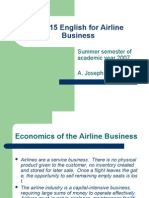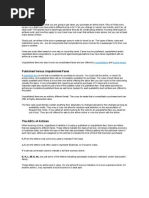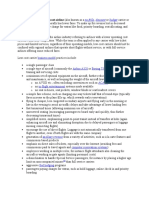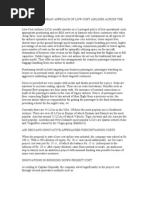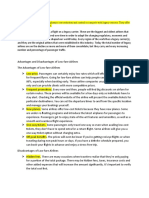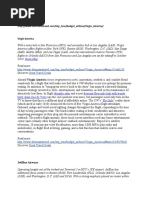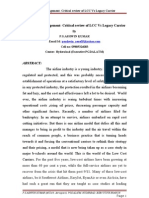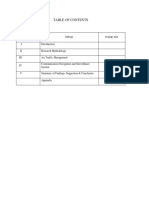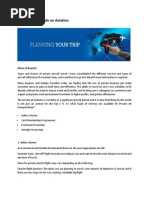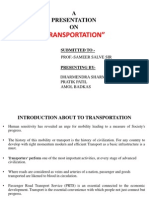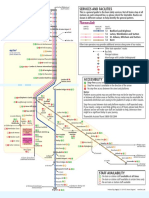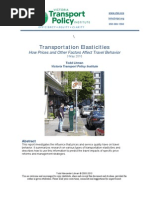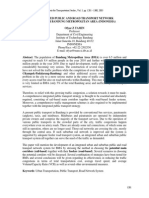0 ratings0% found this document useful (0 votes)
30 viewsThe Airport Experience Final
The Airport Experience Final
Uploaded by
ShevaMarieAlfecheThe document discusses how seating assignments on flights are determined. Passengers can reserve specific seats in advance when booking or at check-in, while exit row seats are usually assigned at the airport. Only airport personnel can ensure those seated in exit rows are able-bodied passengers.
Copyright:
© All Rights Reserved
Available Formats
Download as PPTX, PDF, TXT or read online from Scribd
The Airport Experience Final
The Airport Experience Final
Uploaded by
ShevaMarieAlfeche0 ratings0% found this document useful (0 votes)
30 views15 pagesThe document discusses how seating assignments on flights are determined. Passengers can reserve specific seats in advance when booking or at check-in, while exit row seats are usually assigned at the airport. Only airport personnel can ensure those seated in exit rows are able-bodied passengers.
Original Description:
airport experience
Copyright
© © All Rights Reserved
Available Formats
PPTX, PDF, TXT or read online from Scribd
Share this document
Did you find this document useful?
Is this content inappropriate?
The document discusses how seating assignments on flights are determined. Passengers can reserve specific seats in advance when booking or at check-in, while exit row seats are usually assigned at the airport. Only airport personnel can ensure those seated in exit rows are able-bodied passengers.
Copyright:
© All Rights Reserved
Available Formats
Download as PPTX, PDF, TXT or read online from Scribd
Download as pptx, pdf, or txt
0 ratings0% found this document useful (0 votes)
30 views15 pagesThe Airport Experience Final
The Airport Experience Final
Uploaded by
ShevaMarieAlfecheThe document discusses how seating assignments on flights are determined. Passengers can reserve specific seats in advance when booking or at check-in, while exit row seats are usually assigned at the airport. Only airport personnel can ensure those seated in exit rows are able-bodied passengers.
Copyright:
© All Rights Reserved
Available Formats
Download as PPTX, PDF, TXT or read online from Scribd
Download as pptx, pdf, or txt
You are on page 1of 15
SEATING ASSIGNMENTS (HOW ARE SEATS ASSIGNED?
When making a flight reservation:
Passenger can reserve a specific seat in advance, either by phone with
travel agent or an airline reservationist, or in the internet.
Passengers can also reserve a seat when they check in at the airport: at
the check-in counter, at a self-service kiosk, or at the gate.
The exit rows are usually assigned at the airport check-in because they
require able-bodied passengers to help open the exterior door in an
emergency.
Only airport personnel can make sure that the people sitting in exit-row
seats aren’t , say , children or physically challenged passengers.
THE AIRLINES
-other countries have major airlines too, with considerable service within their
national borders as well as to other countries. Here are some of the biggest
ones, with their codes.
Air France (AF)
AIR New Zealand(NZ)
British Airways(BA)
Japan Airlines or JAL(JL)
KLM-Royal Dutch airlines(KL)
Lufthansa(LH)
Qantas Airways(QF)
SAS Scandinavian Airlines(SK)
Singapore Airlines(SQ)
Virgin Atlantic(VS)
-An airlines offers only service within a country is called Domestic carrier, one
that offers among multiple countries is called an international or foreign carrier.
SECONDARY AIRLINES
-several airlines aren’t as huge as the majors but do offer
considerable service.
For example, Alaska Airlines (AS) has many flights up and
down the western coast of the United States, Canada, and
Mexico and Hawaiian Airlines (HA) offers service among the
islands of Hawaii, as well as to and from the U.S. mainland.
LOW FARE AIRLINES
-sometimes called “low-frills”.
They offer fares that are often lower- sometimes much lower
than the majors. In fact, whenever the low- fare airline
begins an offering service to a city, the major airlines are
forced to compete with equally low fares there.
-also offer highly simplified rate structures compared to the
major airlines.
They tend to target Leisure travelers, because these people
are the most price-sensitive.
REGIONAL AIRLINES
These carriers also called commuters airlines, serve as a
limited section of the country and are often affiliated with
major airline.
Tend to use small jets and prop planes for their service.
Among other significant commuter airlines are, Comair,
Skywest, Mesa, Horizon, and Expressjet.
AIRPORT AND AVIATION MANAGEMENT
Airport Management- concerns itself with making the
operations of an airport efficient, safe, and profitable.
Fixed- base Operators- are companies that provide ground
services and support to the aviation industry.
Airport ancillary services- consist of just about every other
airport- related supplier you can think of. Some are based on-site
at the airport( such as airline, caterers, store, restaurants and
private security firms) , others are based partially or completely
off-site( such as taxis, shuttle, and limo services, airport hotels
car rental firms and bus companies).
Government Organizations- can be the cities or counties
that own the airports (including their police). However, the
government entity that has the ,most crucial presence at
airports is the FAA. The FAA monitors the air travel systems
to ensure safety and manages the airspace above the United
States. Another subsidiary of Department of Transportation is
the TSA, which help the airports and flight safe.
AIRFARES
if your traveling on full-coach fare. Coach fares that
eligible for any discounts( and that cost nearly as much as
business- or –first- class fare) are usually unrestricted fares,
meaning that you can make changes to your itinerary without
incurring penalty. Fares that have discounted are usually
called promotional fares.
how far you advance you buy the ticket. Generally, the
farther in advance you buy, the less you pay. Tickets
purchased less than, say, seven days before the flight will be
charged at full time.
What class of service you bought. Coach almost always
cost less than premium coach, premium coach less than
business, and business less than first. Remember, though,
the difference between full-fare coach and business or first
may not be that much.
What add-on taxes and fees there are. Fuel surcharges,
segment taxes, departure taxes, airport taxes, security fees,
and service fees-all those and more may be tacked on to the
base fare.
Whom you bought it from, or how. The majority of all
airline tickets are bought through travel agencies, both brick-
and- mortar and online
Which airline is involved. Low-fare airlines usually offer better
deals than do their competitors, esp. on last minute flights.
However, some of these airlines like Irelands Ryanair, charge
extra fees for many services that offers airlines include in there
fares.
what time you are flying. Maybe 10 A.M flight from San
Francisco to Atlanta is nearly sold out ( so the prices on the few
remaining seats costly). But the 7 A.M flight or even 12:30 A.M
red eye flight will be a lot less expensive because fewer people
are booked on those flights.
You might also like
- You Have Completed Your Check-In Successfully!: Name Seat Boarding Pass FF No. FF TierDocument1 pageYou Have Completed Your Check-In Successfully!: Name Seat Boarding Pass FF No. FF Tierjacs127No ratings yet
- English For Flight AttendantsDocument12 pagesEnglish For Flight AttendantsSofia RodriguezNo ratings yet
- Measuring Public Transport PerformanceDocument50 pagesMeasuring Public Transport PerformanceKrista JacksonNo ratings yet
- Gateway Case-Study - Preseen - Introductory Overview - Reference Material 1Document2 pagesGateway Case-Study - Preseen - Introductory Overview - Reference Material 1Ahsen RazaNo ratings yet
- Airline EconomicsDocument15 pagesAirline Economicsapi-38143070% (2)
- 3.1 The Truth About Air TravelDocument14 pages3.1 The Truth About Air TravelСвітлана Свирид0% (1)
- teeminology-WPS OfficeDocument33 pagesteeminology-WPS Officerestyleshop99No ratings yet
- 5 Types of AirlinesDocument4 pages5 Types of AirlinesMohamed AhmadNo ratings yet
- Airline TermsDocument8 pagesAirline TermsVenus HatéNo ratings yet
- Airdeccan Case AnalysisDocument24 pagesAirdeccan Case AnalysisSabyasachi Dey100% (1)
- Mod AssiDocument17 pagesMod AssiKhola KhanNo ratings yet
- Full Service Carrier Product Rating Criteria: What Are The Different Classes of Service On A Plane?Document5 pagesFull Service Carrier Product Rating Criteria: What Are The Different Classes of Service On A Plane?Vyl CebrerosNo ratings yet
- Airline Southwest Airlines: Multiple Fare BasisDocument2 pagesAirline Southwest Airlines: Multiple Fare BasisHarshitNo ratings yet
- Airline Southwest Airlines: Multiple Fare BasisDocument2 pagesAirline Southwest Airlines: Multiple Fare BasisHarshitNo ratings yet
- Airlines: About First ResearchDocument16 pagesAirlines: About First ResearchIza YulizaNo ratings yet
- Type of AirlinesDocument11 pagesType of AirlinesNikiNo ratings yet
- Airline: No-Frills Discount BudgetDocument4 pagesAirline: No-Frills Discount BudgetsharathjeshurunNo ratings yet
- Heliport Stolport: AerodromeDocument10 pagesHeliport Stolport: AerodromeGunjan JainNo ratings yet
- The DeccanDocument11 pagesThe DeccanDev R. DiwakarNo ratings yet
- Air Travel and Tours: Chapter ObjectivesDocument22 pagesAir Travel and Tours: Chapter Objectiveshưng nguyễnNo ratings yet
- Air Travel and Tours: Chapter ObjectivesDocument22 pagesAir Travel and Tours: Chapter ObjectivesLê Thành LuânNo ratings yet
- Airline TipsDocument3 pagesAirline TipsA SmithNo ratings yet
- Low Cost AirlinesDocument2 pagesLow Cost AirlinesMarnelli CatalanNo ratings yet
- 1 Introduction To Airline OperationDocument26 pages1 Introduction To Airline OperationRania100% (1)
- Micro Economics Assignment - Airline Industry - SanthoshDocument4 pagesMicro Economics Assignment - Airline Industry - SanthoshSanthosh TholpdayNo ratings yet
- Handling - Check InIssue of Boarding Pass - Customs and Immigration Formalities.Document19 pagesHandling - Check InIssue of Boarding Pass - Customs and Immigration Formalities.Neha BhatiaNo ratings yet
- Standby Air Travel: United Airlines Southwest AirlinesDocument9 pagesStandby Air Travel: United Airlines Southwest AirlinesDevika JoharNo ratings yet
- Airline EconomicsDocument36 pagesAirline Economicschuchuking100% (2)
- Airport ResearchDocument15 pagesAirport ResearchDessa TauroNo ratings yet
- Lecture 8Document17 pagesLecture 8Mahnoor ShahNo ratings yet
- United Airlines Seating AssignmentDocument8 pagesUnited Airlines Seating Assignmentafmohvblm100% (1)
- Emirates (EK) - Baggage Prices, Delay Stats, RatingsDocument10 pagesEmirates (EK) - Baggage Prices, Delay Stats, RatingsAniee AbbasiNo ratings yet
- Route Map: Great Travel DealsDocument4 pagesRoute Map: Great Travel Dealsmoumitaghosh11No ratings yet
- Budget+Airlines+_+How+Low+Cost+Carriers+OperateDocument1 pageBudget+Airlines+_+How+Low+Cost+Carriers+OperateDaiane Cardoso LopesNo ratings yet
- Airport Management Concerns Itself With Making The Operations of An Airport EfficientDocument1 pageAirport Management Concerns Itself With Making The Operations of An Airport Efficientjoel lacayNo ratings yet
- 1 Introduction To Airline OperationDocument27 pages1 Introduction To Airline OperationRaniaNo ratings yet
- S23 SBLPreseenDocument12 pagesS23 SBLPreseenHussain MustunNo ratings yet
- AirportDocument14 pagesAirportMuzammil OmariNo ratings yet
- Research Proposal On Airline IndustryDocument5 pagesResearch Proposal On Airline IndustrygetmyshijoNo ratings yet
- Modul 5 CRS Dan GDSDocument18 pagesModul 5 CRS Dan GDSAqilahNo ratings yet
- Airport Retail Quick GuideDocument9 pagesAirport Retail Quick GuideRicardo RosaNo ratings yet
- Aiport VocabularyDocument14 pagesAiport VocabularyChouaib Ben BoubakerNo ratings yet
- Southwest Airline Case StudyDocument6 pagesSouthwest Airline Case Studyakbar_bhattiNo ratings yet
- Chapter 6 Air Travel and ToursDocument22 pagesChapter 6 Air Travel and Toursmonika ashokNo ratings yet
- Basic Airport VocabularyDocument6 pagesBasic Airport Vocabularymelicastillo96No ratings yet
- Micro Economics Assignment Airline Industry SanthoshDocument4 pagesMicro Economics Assignment Airline Industry SanthoshSagar HindoriyaNo ratings yet
- Airline Management - Critical Review of LCC Vs Legacy Carrier ATM-IIDocument12 pagesAirline Management - Critical Review of LCC Vs Legacy Carrier ATM-IISlobodan Glisic100% (2)
- Alphabetical List of Frequent Flyer Terms and AbbreviationsDocument14 pagesAlphabetical List of Frequent Flyer Terms and Abbreviationsali leventeliNo ratings yet
- Views Visions - Transportation - Moore Article (2) - CDocument2 pagesViews Visions - Transportation - Moore Article (2) - CMichael A. SecrettNo ratings yet
- BudgetDocument9 pagesBudgetBoston SportsNo ratings yet
- SouthWest Airlines Case StudyDocument6 pagesSouthWest Airlines Case StudySadique ChowdhuryNo ratings yet
- Pgs (6marks) Set-2Document4 pagesPgs (6marks) Set-2NivieNo ratings yet
- Unit 4 AviationDocument14 pagesUnit 4 AviationYash ChhabraNo ratings yet
- InvestopediaDocument2 pagesInvestopediaNazareth HarfoushNo ratings yet
- AE Week 3 Airline Economics SummaryDocument45 pagesAE Week 3 Airline Economics SummaryÖmer YağmurNo ratings yet
- Nil ODocument41 pagesNil ONiloferNo ratings yet
- International Guide On AviationDocument4 pagesInternational Guide On AviationRuth Addie MendezNo ratings yet
- AirportsDocument10 pagesAirportsMagalhãesNo ratings yet
- TRM 409.01 Overbooking IssueDocument26 pagesTRM 409.01 Overbooking IssueNeşe RomanNo ratings yet
- Airlines Services Lecture 3Document35 pagesAirlines Services Lecture 3minaNo ratings yet
- (Case) Is Ryanair The Southwest Airlines of Europe?Document7 pages(Case) Is Ryanair The Southwest Airlines of Europe?Strategic ManagementNo ratings yet
- "Transportation": A Presentation ONDocument13 pages"Transportation": A Presentation ONcome2pratikNo ratings yet
- Thameslink Route Map LondonDocument1 pageThameslink Route Map LondonAlexandru ChinciuNo ratings yet
- 12 07 I 91 NewsletterDocument4 pages12 07 I 91 NewsletterOwenFDNo ratings yet
- Bandra-Worli Sea LinkDocument112 pagesBandra-Worli Sea LinkRamchandra SalunkeNo ratings yet
- FAA Approval For Drone Use in Polk CountyDocument8 pagesFAA Approval For Drone Use in Polk CountyJanelle Irwin TaylorNo ratings yet
- Train Vs BusesDocument6 pagesTrain Vs BusesJULIUS JULIUSNo ratings yet
- Highway Maintenance and RehabilitationDocument41 pagesHighway Maintenance and Rehabilitationkhessiejulle67% (9)
- Devoir de Contrôle N°1 Collège Pilote - Anglais - 8ème (2017-2018) MR Hajer BoudenDocument3 pagesDevoir de Contrôle N°1 Collège Pilote - Anglais - 8ème (2017-2018) MR Hajer BoudenSabriiiii1275% (4)
- Pro Station Master Study MaterialDocument295 pagesPro Station Master Study Materialhodibaaba1No ratings yet
- Geometric DesignDocument15 pagesGeometric DesignHanamant HunashikattiNo ratings yet
- Label của bản tin ACARSDocument37 pagesLabel của bản tin ACARScongthanh160689No ratings yet
- Transportation ElasticitiesDocument75 pagesTransportation ElasticitiesparkingeconomicsNo ratings yet
- TOEIC-PREPOSITIONSDocument2 pagesTOEIC-PREPOSITIONSwalid abaidiNo ratings yet
- Ticket - AbibusDocument1 pageTicket - Abibusdvs123456No ratings yet
- Shree Cement Ltd-People First - Project-Mobility Questionaire For Assessment of Present SystemDocument3 pagesShree Cement Ltd-People First - Project-Mobility Questionaire For Assessment of Present SystemStephen BridgesNo ratings yet
- Street Light Standard For Australia PDFDocument70 pagesStreet Light Standard For Australia PDFLokesh Krishnappa100% (1)
- Flying in Europe NDocument44 pagesFlying in Europe Ndiana_veronicaNo ratings yet
- AD AD AD AD AD AD: VHHHFPLMDocument2 pagesAD AD AD AD AD AD: VHHHFPLMphilip00165No ratings yet
- Eastside Transportation Study Executive Summary ReportDocument32 pagesEastside Transportation Study Executive Summary ReportPeterborough ExaminerNo ratings yet
- Phrasal Verb Meaning Example A Abide byDocument8 pagesPhrasal Verb Meaning Example A Abide byPame MartinelliNo ratings yet
- Unit 3: Happy Holidays? Types of Holiday Holiday Location Locations and Places To Stay Holiday ActivitiesDocument3 pagesUnit 3: Happy Holidays? Types of Holiday Holiday Location Locations and Places To Stay Holiday ActivitiesJavier AmendolareNo ratings yet
- Proceedings of The Eastern Asia Society For Transportation Studies, Vol. 5, Pp. 1281 - 1300, 2005Document3 pagesProceedings of The Eastern Asia Society For Transportation Studies, Vol. 5, Pp. 1281 - 1300, 2005Riki OktaNo ratings yet
- Proposed Draft Bill For Creating A Commuters' Bill of RightsDocument10 pagesProposed Draft Bill For Creating A Commuters' Bill of RightsRapplerNo ratings yet
- Architectural Design 8 - Intl Airport ProbDocument4 pagesArchitectural Design 8 - Intl Airport ProbtheridgearchitectsNo ratings yet
- Indian Railway Commercial CircularDocument3 pagesIndian Railway Commercial CircularPrashanth Rao PNo ratings yet
- Flooring & RoofingDocument59 pagesFlooring & RoofingSyark BaitNo ratings yet




